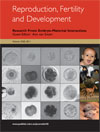
Reproduction, Fertility and Development
Volume 23 Number 8 2011
RESEARCH FRONT: Embryo–Maternal Interactions
RD10285 Fertilisation in the horse and paracrine signalling in the oviduct
This paper reviews the most relevant data on the role of the oviduct and its secretions on equine fertilisation. Limited data are available on the influence of oviduct in final oocyte maturation and gamete fusion, most studies focus on the role of the oviduct in equine sperm function. Some candidate molecules for gamete–oviductal interactions have been identified in the horse.
RD10294 Maternal recognition of pregnancy in the horse: a mystery still to be solved
Maternal recognition of pregnancy is the sum of events leading to maintenance of pregnancy. The horse is one of the few domestic species in which the conceptus-derived pregnancy recognition signal has not been identified. The current review highlights aspects of maternal recognition of pregnancy such as the alteration of endometrial prostaglandin F2α release and oxytocin responsiveness, the importance of conceptus mobility, the role of conceptus-derived estrogens and prostaglandins as potential anti-luteolytic factors, and findings from recently published microarray studies.
RD11140 Embryo–maternal communication: signalling before and during placentation in cattle and pig
Communication during early pregnancy is essential for successful reproduction. In this review we address the beginning of the communication between mother and developing embryo; including morphological and transcriptional changes in the endometrium as well as epigenetic regulation mechanisms directing the placentation. An increasing knowledge of the embryo–maternal communication might not only help to improve the fertility of our farm animals but also our understanding of human health and reproduction.
RD11032Computational modelling of maternal interactions with spermatozoa: potentials and prospects
Understanding the interactions which occur between sperm, oocytes, the early embryo and the female reproductive tract is essential for combating the causes of disease and infertility. Computational modelling is presented as a tool for managing this complexity and helping to understand how the combined interactions between all components within a system result in the observed behaviour. Computational modelling of the reproductive system is in its infancy and has the potential to significantly enhancing research and understanding of reproductive processes.
RD11079 Dose-dependent effects of gonadotropin on oocyte developmental competence and apoptosis
The safety of stimulation protocols used in human assisted reproductive technologies (ART) is now of big concern. To highlight the importance of judicious use of gonadotropins (Gn), we designed the present study which demonstrated that extremely high concentrations of Gn have detrimental effects on oocyte nuclear maturation, early embryonic development and cumulus cell apoptosis. The results can be applied to clinical stimulation protocols to reduce the potential risk in ART.
RD10197 Presence of histone H3 acetylated at lysine 9 in male germ cells and its distribution pattern in the genome of human spermatozoa
The most recent thinking is that paternally derived histones convey important epigenetic information to the zygote that can affect subsequent development. Applying sperm chromatin immunopreciptitation with antibodies against acetylated histone H3 at lysine 9 (H3K9ac) in combination with ENCODE Microarray (ChIP-chip), we identified many developmentally important genes interacting with H3K9ac in sperm of fertile donors and we also found lack of this interaction in subfertile patients. Aberrations in sperm histone code may represent one reason for epigenetic mediated infertility.
RD11026 Using cell banks as a tool in conservation programmes of native domestic breeds: the production of the first cloned Anatolian Grey cattle
The aim of this study was to clone native Anatolian Grey cattle by using different donor cell types such as fibroblast, cartilage and granulosa cells cryopreserved in a gene-bank. One male and four female calves from different cell types were born healthy and at normal birth weights. The results showed that well-established nuclear transfer protocols could be useful in conserving endangered species by using somatic cells from a gene-bank.
RD10290 Breed differences in fetal and placental development and feto-maternal amino acid status following nutrient restriction during early and mid pregnancy in Scottish Blackface and Suffolk sheep
In sheep, appropriate nutrition during pregnancy is important for fetal growth and lamb well-being, but do different breeds respond differently to pregnancy under-nutrition? This study highlighted differences in fetal organ size, placental development and maternal-fetal amino acid status between a breed selected for lean tissue growth (Suffolk) and a less-selected hill-breed (Scottish Blackface). The results provide new information on how nutrients are partitioned between the maternal and fetal body.
RD11027 Bone morphogenetic protein-6 (BMP-6): mRNA expression and effect on steroidogenesis during in vitro maturation of porcine cumulus oocyte complexes
The ovum is believed to have a central role in regulating cell functions of the ovarian follicle. The present findings indicate that the protein BMP-6 (bone morphogenetic protein 6) is a factor secreted by the ovum which is involved in preventing premature maturing by enhancing estradiol synthesis. Thus, BMP-6 seems to be an important factor for preparing the ovum for successful fertilisation.



